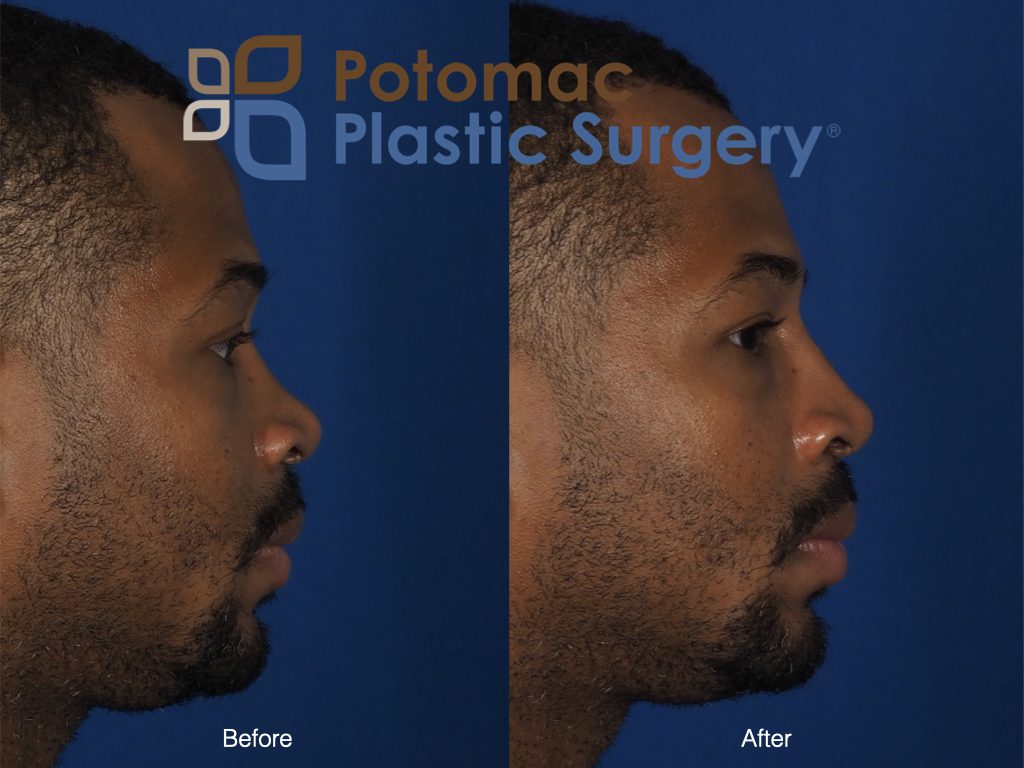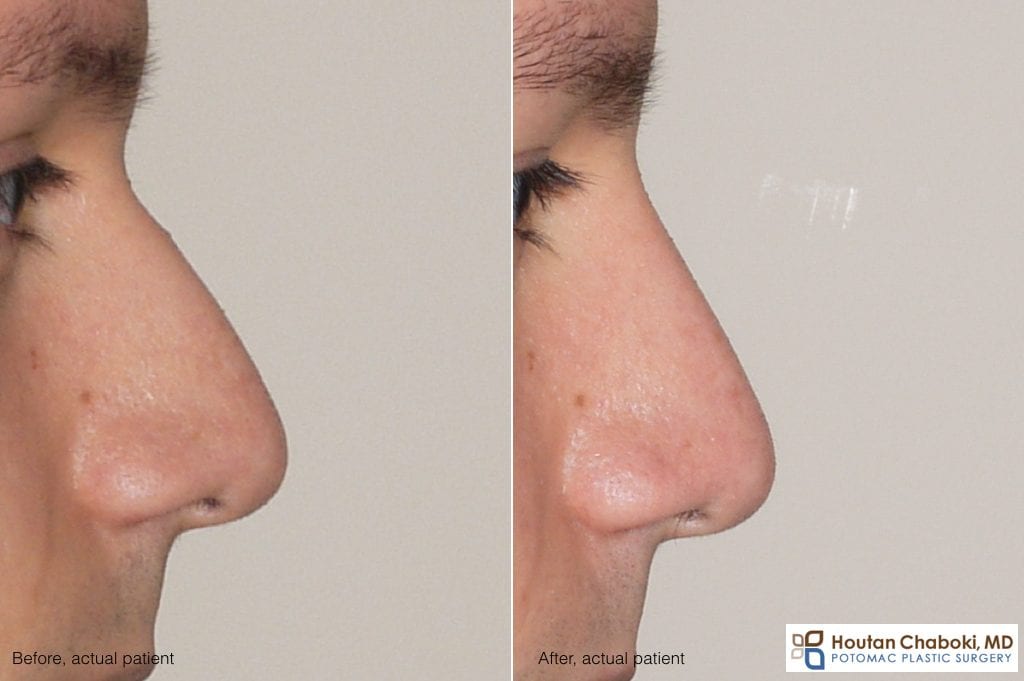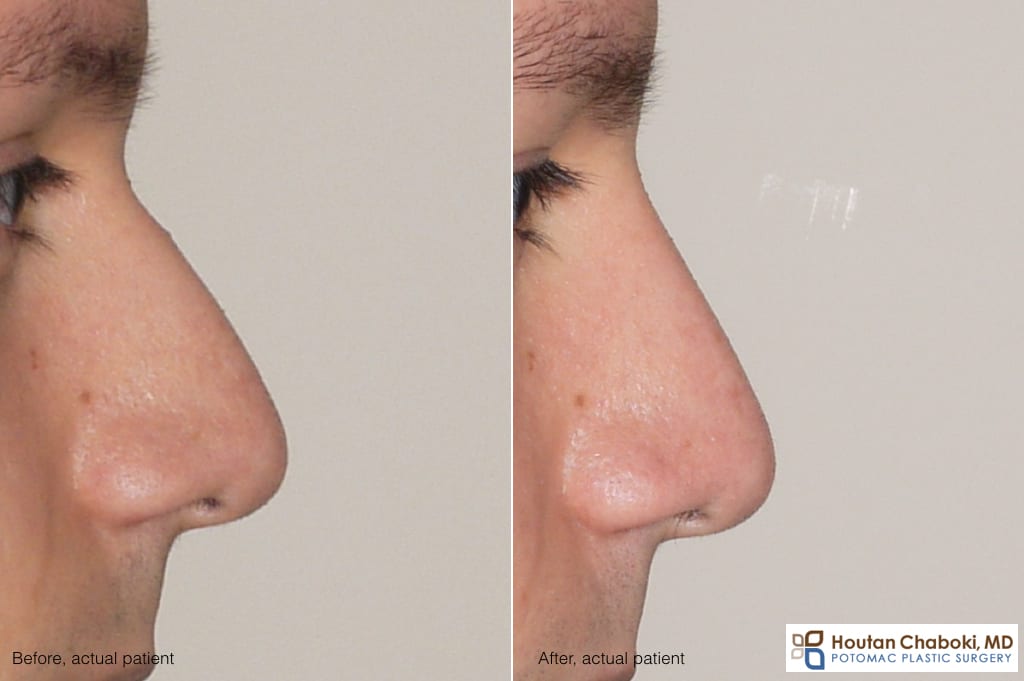Nasal surgery with rhinoplasty and septoplasty remains one of the most common facial plastic surgery procedures worldwide, especially in younger patients. For these younger patients, Botox® and facial filler injections are also very popular procedures to enhance the face. It was natural that at some point these fillers and Botox treatments would be used to reshape the nose without surgery, otherwise known as a liquid lift of the nose.
Facial fillers

Nonsurgical rhinoplasty with filler in the nose bridge by Dr. Chaboki.
Cosmetic surgeons use a large variety of facial fillers to rejuvenate the face, but hyaluronic acid fillers are the most popular for the nose. Restylane® and Belotero® are examples of hyaluronic acid fillers that plastic surgeons may use to alter the nose without surgery. The recovery after a liquid lift is much easier than surgery. Results are immediate and very long-lasting, but not necessarily permanent.
Washington DC rhinoplasty surgeons primarily use facial fillers on the upper 2/3 of the nose and typically avoid injecting fillers in the tip of the nose. Injections of the nasal tip with fillers have more medical and cosmetic risks. Rhinoplasty surgeons may use facial fillers in a liquid lift of the nose in the following ways for both primary rhinoplasty or revision rhinoplasty:
- root of the nose to reduce the prominence of a nasal bump
- side or top of nose to improve concavities, depressions, or asymmetries
- top of bridge to augment and provide more definition
Wrinkle relaxers
Wrinkles relaxers (referred to technically as neuromodulators by plastic surgeons) are used differently than facial fillers to modify the nose. Examples of wrinkle relaxers are Botox, Dysport®, and Xeomin®. Rhinoplasty specialists use these wrinkle relaxers in the following techniques:
- nasal bridge to reduce wrinkles, otherwise known as “bunny” lines
- sides of the nostrils to help prevent widening of the nostrils when one smiles
- junction of the upper lip and center of the nose to help reduce a droopy tip when smiling
- upper lip area near nose to help soften wrinkles under nose
The effect from these relaxers develop gradually over several days. Non-surgical rhinoplasty with neuromodulators is also temporary, lasting a few months. The degree of improvement is generally more subtle as compared to plastic surgery of the nose.
Primary or Revision rhinoplasty
A liquid lift of the nose with facial fillers or neuromodulators are a potential option for patients considering primary or revision rhinoplasty. Rhinoplasty is a tailored procedure for each patient, and there isn’t a “best” approach. Top rhinoplasty specialists use many methods of nasal procedures to reshape the nose.
Surgery remains the primary method for most patients to permanently improve the nose. However, rhinoplasty may not be appropriate for all patients. A liquid lift of the nose can be an option to consider. Dr. Chaboki provides comprehensive solution for patients seeking primary or revision nasal procedure and has contributed to scientific research on non-surgical rhinoplasty.
Have you considered rhinoplasty or revision rhinoplasty? Share your thoughts below.



Hi could non surgical rhinoplasty can it cause dry eyes or burning sensations around eyes? I’ve heard their might be some reports on it but not followed up on due to the low numbers…. if filler was placed in radix or bridge close to glabella?
Thank you for visiting our website and reading the blog. The most common side effects of facial fillers include injection site irritation, such as redness, swelling, pain, tenderness, firmness, lumps, bumps, bruising, discoloration, and itching. Side effects of facial filler injections are typically minor, temporary, and resolve on their own. Patients should speak with their plastic surgeon or dermatologist to help determine if they are a candidate for facial fillers.
Best,
Dr. Chaboki
What is the cost estimate for a non-permanent nonsurgical nose job?
Out-of-pocket costs of nonsurgical rhinoplasty are generally less compared to surgery. Plastic surgery prices will vary by each office, material used, complexity, and individual circumstances. In addition, while many may just need one treatment, some patients require more than one treatment to tweak and enhance their final results.
Best,
Dr. Chaboki